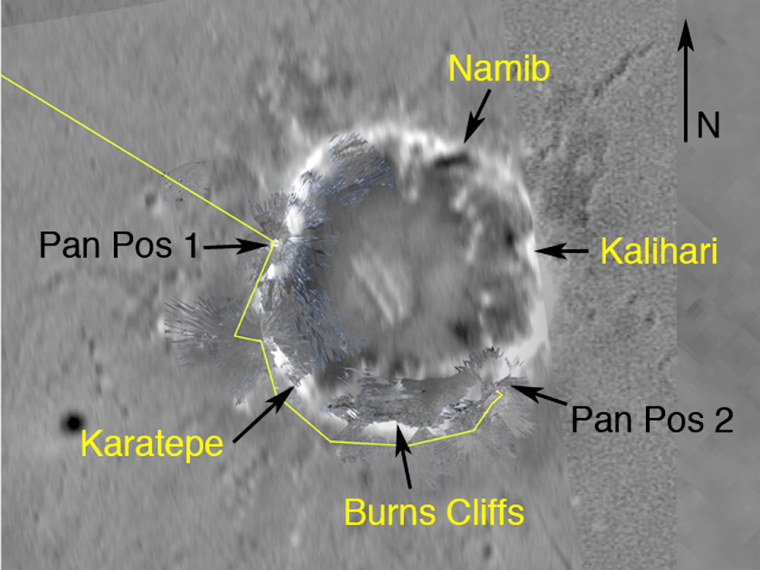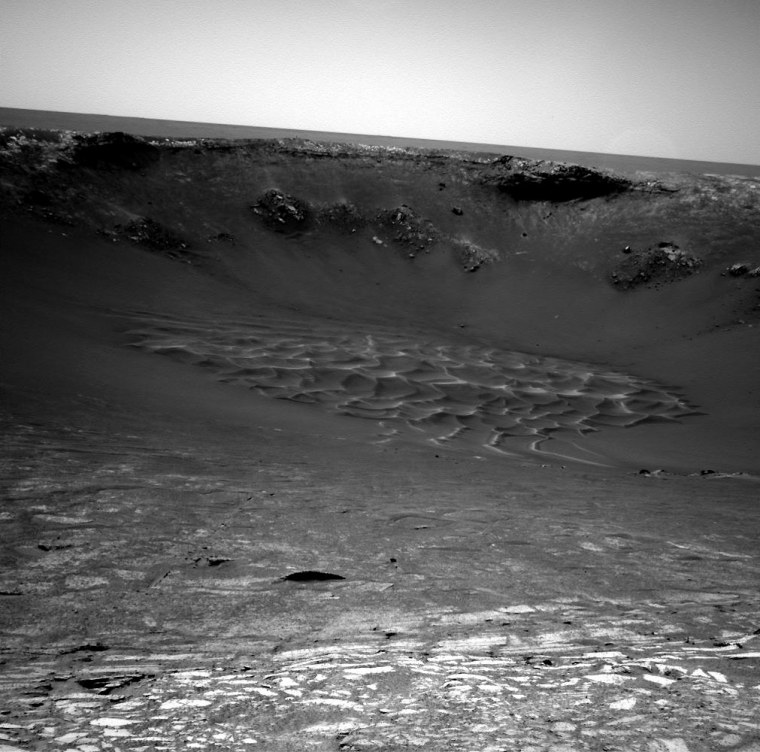That double-header of a rover mission to Mars — Spirit and Opportunity — are both moving toward fresh rounds of science-gathering and could survive far longer than once expected.
Opportunity at Meridiani Planum, has received the go-ahead to "deep dive" into a large impact crater dubbed Endurance, while on the other side of Mars, the Spirit rover at Gusev Crater is within days of reaching the Columbia Hills and studying geology that appears to offer unique insight into that region’s history.
Meanwhile, the scientists and engineers who operate the robotic twosome are looking at "wintering over" schemes — putting the mechanized explorers in hibernation mode, and then restarting their duties on Mars next spring.
Mars rover scientists detailed future plans at last week’s American Astronomical Society meeting, held in Denver.
Taste-testing the hills
"Things are about to get very, very interesting," said Steve Squyres of Cornell University, principal investigator for the science payload carried on each of the Mars rovers.
At Gusev Crater, Spirit has been making remarkable progress driving toward the Columbia Hills. "The hills are starting to get too big. So the images cut off the top of the hills … and that’s kinda cool," Squyres said. Those pictures of the hills already reveal exposed bedrock and other features that look "very interesting indeed," he added.
"We should pull up at the base of those hills within another week, or a little bit more. Then we’ll see what we see," Squyres said.
A preliminary plan is to have Spirit traverse southward, along the margin between the hills and the plains of Gusev Crater. In that direction lies a variety of geological features. "I don’t have high confidence to be able to climb high into the hills," Squyres said. "But as we get closer and closer … I can see that plan being altered significantly."
Squyres told the AAS audience that Spirit will first "take a taste" of the hills with its science gear, "then hang a right." Exactly what the traverse will be like after that will be decided by what is found, he said.
"That’s what is interesting about this mission. You can’t plan too far ahead because Mars will surprise you," Squyres explained.
Enduring Endurance
The Opportunity rover at Meridiani Planum is perched at the edge of the stadium-sized Endurance impact crater — a feature roughly 65 feet (20 meters) deep and brimming with thick and old layers of bedrock and rich in sulfates, hematite and basalts.

Careful study has been done of a section of Endurance tagged "Karatepe" — a layered band of rock. That piece of real estate is seen by rover drivers at the Jet Propulsion Laboratory in Pasadena, Calif., as a safe entrance ramp into the roughly 430-foot-wide (130-meter-wide) crater. This spot is less steep and more approachable than the rest of the crater’s rocky outcrops.
"It is a rocky surface, but there are these little spherules we call blueberries all over the place," said Jim Bell of Cornell University, leader of the panoramic camera team for the Mars Exploration Rovers.
Bell told Space.com that the potential risk of having Opportunity drive on a plywoodlike surface covered with spherules acting like ball bearings has undergone detailed assessment. "The slopes are gentle enough. The rover wouldn’t go tumbling down the hill … but it would slide and be hard to control. You could get in a situation where you sit spinning your wheels trying to get back up," he said.
Big cliffs
Squyres said Endurance crater is "just a stunning, beautiful, spectacular place." But such a hole in the ground "can be a permanent rover trap," he added, and "a one-way trip doesn’t appeal to any of us very much."
"This is a dangerous place for a rover. There are big cliffs that we could drive off and die. So we’ve been very careful here," Squyres said.
In going into the crater, and taking a prudent route, Squyres said that Opportunity would drive slowly forward with its robot arm stretched out, steer to a band of exposed rock, do its business and then back out, straight up the hill.
"The vehicle goes backwards as well as it goes forward," Squyres pointed out.
So far, so good
Regarding the overall health of the twin vessels of Mars exploration, both robots continue to perform well.
Several things could kill the rovers, such as the failure of a key electronic part or the wearing-down of a critical mechanical piece of equipment. To date it has been "so far, so good" as the robots continue to march their way across the Martian landscape.
"If both of those things hold out, then what is probably going to get us is dust buildup on the solar arrays," Squyres said. "Right now, we’re seeing a pretty sharp drop-off in solar power on both vehicles. That’s a consequence of both the onset of winter and declining solar power because of the dust buildup."
Despite this issue, Squyres said rover engineers think the two robots will survive through the winter and to the next spring on Mars.
Spring back to life?
Staying alive is tougher for Spirit than it is for Opportunity. That’s due to Spirit’s higher latitude exploration zone on the Red Planet, Squyres reported. "We’re already looking at maps of the Columbia Hills and trying to pick a good spot to winter over," he said.
Part of the wintering-over strategy will involve positioning the rovers to soak up as much continuous sunlight, even as the sun moves low in the Martian sky, Bell said. Secondly, the robots are to be oriented so that communication links with orbiters zipping overhead are maximized, he pointed out.
"It’s a combination of those two things — finding that sweet spot," Bell said.
Coming out of hibernation mode in the spring, "we’re looking at the final demise of these vehicles perhaps as late as the onset of our second winter on Mars," Squyres concluded.
